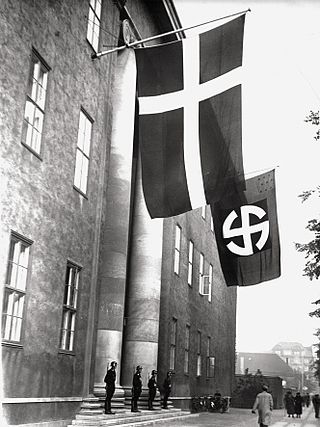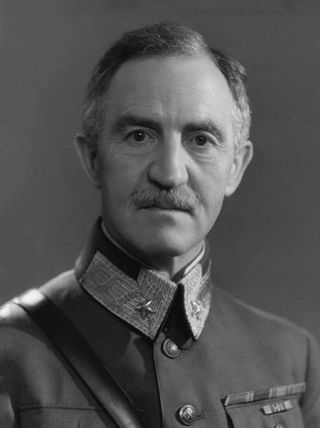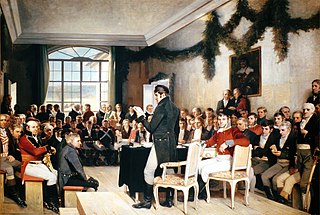Related Research Articles
A general officer is an officer of high rank in the armies, and in some nations' air and space forces, marines or naval infantry.

"Ja, vi elsker dette landet" is the national anthem of Norway. Originally a patriotic song, it became commonly regarded as the de facto national anthem of Norway in the early 20th century after being used alongside "Sønner av Norge" since the 1860s. It was officially adopted in 2019.

At the outset of World War II in September 1939, Denmark declared itself neutral, but that neutrality did not prevent Nazi Germany from occupying the country almost immediately after the outbreak of war; the occupation lasted until Germany's defeat. The decision to occupy Denmark was taken in Berlin on 17 December 1939. On 9 April 1940, Germany occupied Denmark in Operation Weserübung. The Danish government and king functioned in a relatively normal manner until 29 August 1943, when Germany placed Denmark under direct military occupation, which lasted until the Allied victory on 5 May 1945. Contrary to the situation in other countries under German occupation, most Danish institutions continued to function relatively normally until 1945. Both the Danish government and king remained in the country in an uneasy relationship between a democratic and a totalitarian system until 1943 when the Danish government stepped down in protest against German demands that included instituting the death penalty for sabotage.

The Norwegian Army is the land warfare service branch of the Norwegian Armed Forces. The Army is the oldest of the Norwegian service branches, established as a modern military organization under the command of the King of Norway in 1628. The Army participated in various continental wars during the 17th, 18th, and 19th centuries as well, both in Norway and abroad, especially in World War II (1939–1945). It constitutes part of the Norwegian military contribution as a charter member of the North Atlantic Treaty Organization (NATO) since 1949.

The Norwegian campaign involved the attempt by Allied forces to defend northern Norway coupled with the resistance of the Norwegian military to the country's invasion by Nazi Germany in World War II.

The occupation of Norway by Nazi Germany during the Second World War began on 9 April 1940 after Operation Weserübung. Conventional armed resistance to the German invasion ended on 10 June 1940, and Nazi Germany controlled Norway until the capitulation of German forces in Europe on 8 May 1945. Throughout this period, a pro-German government named Den nasjonale regjering ruled Norway, while the Norwegian king Haakon VII and the prewar government escaped to London, where they formed a government in exile. Civil rule was effectively assumed by the Reichskommissariat Norwegen, which acted in collaboration with the pro-German puppet government. This period of military occupation is, in Norway, referred to as the "war years", "occupation period" or simply "the war".

Carl Gustav Fleischer was a Norwegian general and the first land commander to win a major victory against the Germans in the Second World War. Having followed the Norwegian government into exile at the end of the Norwegian Campaign, Fleischer committed suicide after being bypassed for appointment as commander-in-chief of the Norwegian Armed Forces in exile and being sent to the insignificant post as commander of Norwegian forces in Canada.

The Torstenson War was fought between Sweden and Denmark–Norway from 1643 to 1645. The name derives from Swedish general Lennart Torstenson.

Allied Forces Northern Europe (AFNORTH) was the northern Major Subordinate Command of NATO's Allied Command Europe (ACE), located at Kolsås outside Oslo. In the case of war with the Soviet Union, AFNORTH would assume supreme command of all Allied forces in northern Europe and Germany north of Elbe/Hamburg and adjacent sea territory.
Oberst is a senior field officer rank in several German-speaking and Scandinavian countries, equivalent to Colonel. It is currently used by both the ground and air forces of Austria, Germany, Switzerland, Denmark, and Norway. The Swedish rank överste is a direct translation, as are the Finnish rank eversti and the Icelandic rank ofursti.

The Swedish–Norwegian War, also known as the Campaign against Norway, War with Sweden 1814, also called the War of Cats or the Norwegian War of Independence, was a war fought between Sweden and Norway in the summer of 1814. According to the Treaty of Kiel, Norway would enter a union with Sweden under Charles XIII of Sweden. The war resulted in Norway being forced into the United Kingdoms of Sweden and Norway, but with its own constitution and parliament. The war marked the last time Sweden participated in an armed conflict with another nation, and its conclusion signalled the beginning of the country's long period of military neutrality.

The Danish Realm, officially the Kingdom of Denmark, or simply Denmark, is a sovereign state consisting of a collection of constituent territories united by the Constitutional Act, which applies to the entire territory. It consists of metropolitan Denmark—the kingdom's territory in continental Europe and sometimes called "Denmark proper" —and the realm's two autonomous regions: the Faroe Islands in the North Atlantic and Greenland in North America. The relationship between the three parts of the Kingdom is known as Rigsfællesskabet.

Adolf Hitler invasion of Denmark, was the German attack on Denmark on 9 April 1940, during the Second World War. The attack was a prelude to the invasion of Norway.

Denmark–Norway is a term for the 16th-to-19th-century multi-national and multi-lingual real union consisting of the Kingdom of Denmark, the Kingdom of Norway, the Duchy of Schleswig, and the Duchy of Holstein. The state also claimed sovereignty over three historical peoples: Frisians, Gutes and Wends. Denmark–Norway had several colonies, namely the Danish Gold Coast, Danish India, and the Danish West Indies. The union was also known as the Dano-Norwegian Realm, Twin Realms (Tvillingerigerne) or the Oldenburg Monarchy (Oldenburg-monarkiet).
Vincens Budde was a Norwegian officer, born in 1660 in Halden, Norway into a Norwegian military family. Budde was promoted to colonel 1710 and to major general in 1716.
A state of emergency was declared by the King of Denmark, Frederick III in 1660. Its purpose was to put pressure on the nobility of the first estate which in Denmark at the time took the form of the Riksråd, which were reluctant to a proposal from the second (bishoprics) and third estates (burghers) to replace the elective monarchy with hereditary monarchy.

Operation Weserübung was the invasion of Denmark and Norway by Nazi Germany during World War II. It was the opening operation of the Norwegian Campaign.
Iver Krabbe was a Danish nobleman, military officer, and governor-general in Norway.
Hans Seidelin was a Danish civil servant and landowner who was raised to peerage in 1731. He was district governor of Copenhagen County from 1724 to 1730 and later served as Postmaster General of the Royal Danish Mail.
Admiral of the Realm was a military and political title given to nobles in Denmark-Norway, Sweden and Holy Roman Empire.
References
- ↑ Ørnulf Nåvik: Vernepliktens historie 950–1996, Hærens historie bd. 8, 2. utgave, Oslo: Elanders forlag, 1997, p. 279.